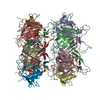+Search query
-Structure paper
| Title | Structure of the siphophage neck-Tail complex suggests that conserved tail tip proteins facilitate receptor binding and tail assembly. |
|---|---|
| Journal, issue, pages | PLoS Biol, Vol. 21, Issue 12, Page e3002441, Year 2023 |
| Publish date | Dec 14, 2023 |
 Authors Authors | Hao Xiao / Le Tan / Zhixue Tan / Yewei Zhang / Wenyuan Chen / Xiaowu Li / Jingdong Song / Lingpeng Cheng / Hongrong Liu /  |
| PubMed Abstract | Siphophages have a long, flexible, and noncontractile tail that connects to the capsid through a neck. The phage tail is essential for host cell recognition and virus-host cell interactions; ...Siphophages have a long, flexible, and noncontractile tail that connects to the capsid through a neck. The phage tail is essential for host cell recognition and virus-host cell interactions; moreover, it serves as a channel for genome delivery during infection. However, the in situ high-resolution structure of the neck-tail complex of siphophages remains unknown. Here, we present the structure of the siphophage lambda "wild type," the most widely used, laboratory-adapted fiberless mutant. The neck-tail complex comprises a channel formed by stacked 12-fold and hexameric rings and a 3-fold symmetrical tip. The interactions among DNA and a total of 246 tail protein molecules forming the tail and neck have been characterized. Structural comparisons of the tail tips, the most diversified region across the lambda and other long-tailed phages or tail-like machines, suggest that their tail tip contains conserved domains, which facilitate tail assembly, receptor binding, cell adsorption, and DNA retaining/releasing. These domains are distributed in different tail tip proteins in different phages or tail-like machines. The side tail fibers are not required for the phage particle to orient itself vertically to the surface of the host cell during attachment. |
 External links External links |  PLoS Biol / PLoS Biol /  PubMed:38096144 / PubMed:38096144 /  PubMed Central PubMed Central |
| Methods | EM (single particle) |
| Resolution | 3.2 - 4.0 Å |
| Structure data | EMDB-36844, PDB-8k35: EMDB-36845, PDB-8k36: EMDB-36846, PDB-8k37: EMDB-36847, PDB-8k38: EMDB-36848, PDB-8k39: |
| Chemicals |  ChemComp-SF4: |
| Source |
|
 Keywords Keywords | VIRAL PROTEIN / Complex |
 Movie
Movie Controller
Controller Structure viewers
Structure viewers About Yorodumi Papers
About Yorodumi Papers













 escherichia phage lambda (virus)
escherichia phage lambda (virus)